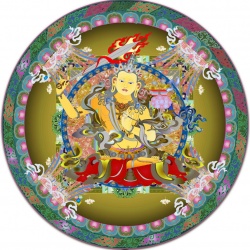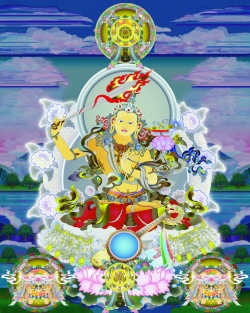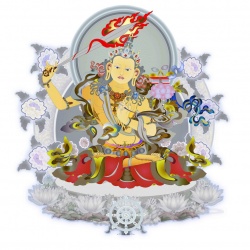One-pointed meditation
One-pointed attention is a powerful aid to meditation. Though our mind may be three-pointed or four-pointed or a hundred-pointed now, we train it to be one-pointed in meditation. Until it is trained, the mind will continue to go its own way, because it is the nature of an untrained mind to wander. Attention can be trained, and no skill in life is greater than the capacity to direct your attention at will.
The benefits of this are numerous. If you have trained your mind to give full attention to one thing at a time, you can achieve your goal in any walk of life. Whether it is science or the arts or sports or a profession, concentration is a basic requirement in every field.
One-pointed attention is helpful in whatever job you are doing. But perhaps the greatest benefit of a trained mind is the emotional stability it brings. In order to get angry, for example, your concentration must be broken – your mind has to change lanes. In order to get afraid, your mind has to change lanes. In order to get upset, your mind has to change lanes. What we all yearn for is a mind that cannot be upset by anything. And we can achieve it, too; but it calls for a lot of work in the training of attention.
When the mind is one-pointed it will be secure, free from tension, and capable of the concentration that is the mark of genius in any field.
The Tibetan term for meditation is gom (2). Gom literally means to familiarize the mind with a concept, aspect of being, or theme. In this context it means to familiarize our mind with a spiritually significant subject, or to integrate the essence of that theme into our stream of consciousness.
It is important to understand something about the types of meditation practiced in Buddhism. The most general categorization of these is into a twofold scheme: analytical meditation; and concentrated meditation.
Analytical meditation is that part of the process of seeking a spiritual path wherein one investigates the relevant aspects of the object (of meditation) by means of reasoning. This helps one to gain strong conviction
and a deeper understanding.
For example, in order to gain realization of the ultimate nature of the mind, it is necessary for us first to understand the mode of its existence. This is not possible without applying some kind of technique, and the success in the application of a technique must be preceded by our having examined well the dynamics of that method.
In general, any kind of mental investigation with an intention of seeking a spiritual goal can be called analytical meditation.
Concentrated meditation is the phase of mental application wherein our mind is able to remain focused on a chosen object for a prolonged period of time. That is to say, concentrated meditation occurs when we understand a technique to the extent that we are able to place the mind on a given subject with some degree of stability. Normally, analytical meditation proceeds the concentrated application.
Within concentrated meditation there is a special method for achieving one-pointedness of mind. This method is called zhiney (3) in Tibetan, and shamatha in Sanskrit. The form and method as well as the goal of zhiney is more or less the same in both the Hindu and Buddhist traditions. That is to say, it is considered to be a common practice of meditation for both. Zhiney is said to be the foundation of all the meditational qualities required for traversing the spiritual paths.
Apart from zhiney, most other Buddhist meditations differ from their Hindu counterparts. These differences are often explained in terms of the perspective if the meditator, and also the objects meditated upon.
In general it is said that Buddhist meditation must be motivated by disinterest with samsaric existence, and by compassionate thoughts towards all sentient beings. Another characteristic of Buddhist meditation is that all the various techniques must be pervaded by the concept of selflessness, or anatma.
As mentioned earlier, meditation can be of different types. In particular I would like to discuss the type called zhiney, or single-pointed meditation.
The practice of zhiney is very important to and useful for us, because it is the principal method for calming and stabilizing the mind. Without it our meditations will not lead to higher realization.
When we have achieved a single-pointed mind our thoughts become clear, calm and stable. In that state we can reason effectively, penetrating deeply into any object of meditation and thus attaining pure realization of its true nature. This penetrative mind is called lhagtong (4) in Tibetan, from the Sanskrit visashyana, which means 'special insight.'
The difference between single-pointed meditation and special insight is that the former principally has the function of pacifying our mind, and thus enabling us to concentrate more deeply on a given subject. Special insight, on the other hand has the ability to analyze and penetrate into the subtle nature of an object.
Thus, if we sincerely seek the realization of truth we should first develop clarity and strength of mind by means of the zhiney training, and then turn this force toward the cultivation of special insight.
Kamalashila, (5) a ninth-century Indian saint-scholar, uses the analogy of a lamp to explain how wisdom arises from a single-pointed mind. When a candle is put in a place where there is no wind, it can clearly illuminate everything around it. Similarly, when our mind becomes clear and still, and is free from agitation and dullness, we are able to develop clear and deep insight into the higher nature of the objects upon which we are meditating.
Among the many objects taken as the focus of meditation for developing single-pointedness, concentrating on our breath as an antidote to discursive thought is very popular and common. Another popular object of concentration in this method is the mind itself.
By developing concentration one passes through nine stages. These nine stages are mentioned according to the gradual development of stability of the mind. I will just list the names of the nine, as this conveys something of a sense of their nature:
inwardly placing the mind on the object;
extending the duration of the concentration;
replacing the mind on the object when it is distracted;
continuously restoring the focus of the mind
achieving a state of inner control;
achieving a state of inner pacification;
achieving a state of complete inner pacification;
achieving single-pointed mind; and
achieving mental equilibrium.
As said earlier meditation has the effect of pacifying the mind. For ascetics and ordinary people alike, peace of mind is essential. If you have a peaceful and clear mind, this will enable you to be more effective in any activity that you undertake, be it temporal or spiritual.
Certain meditations of the tantric path involve visualizing oneself as a particular deity. These generally are to be performed only by initiates; but sometimes they can be performed by non-initiates as a method of cultivating concentration.
The practice of meditation has many beneficial effects, from relieving us of stress, to improving our physical and mental health, and making us into more happy and effective human beings. In the end, though its ultimate goal is to lead us to the states of higher being, nirvana and enlightenment. When we practice it well, all of these beneficial effects become ours.
FOOTNOTES
1.Tib., Rangdon and gZhan-don.
2.Tib., sGom. The term is linked to the word 'to familiarize,' in the sense of to integrate.
3.Tib., Zhi-gnas, which literally means 'abiding in peace,' or 'peaceful repose.' The sense of the term is that the mind rests on the subject of meditation without the disturbances of being distracted by the two obstacles
of torpor and agitation, or mental wandering.
4. Tib., Lhag-mthong, which literally means 'special seeing.' The term is related to the cultivation of wisdom, or sherab (Tib., Shesrab; Sanskrit, prajna).
5. Kamalashila played a very important role in the development of Tibetan religious history. It was he who was invited to Tibet toward the end of the eighth century, and who met and defeated the Chinese monk Huashang Mahayana in debate, an encounter that would set the tone of Tibet's future spiritual direction. The former represented the classical Indian tradition, and the latter represented a form of Chinese ch'an (or zen in Japanese). Kamalashila, one of India's foremost logicians, easily won the contest. From that time onward Tibet looked almost exclusively to India for its spiritual and cultural direction.
This simile is taken from Kamalashila's "Stages of Meditation" (Skt., Bhavanakrama; Tib., bsGomrim; Toh. 3916).




